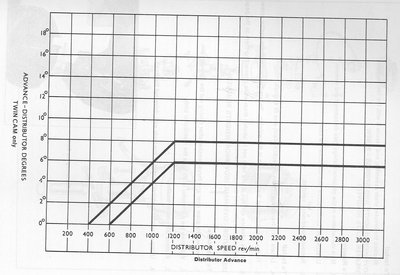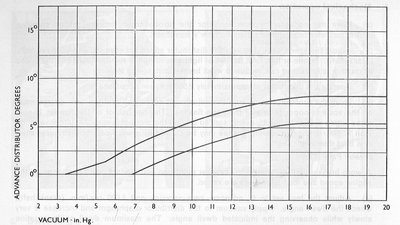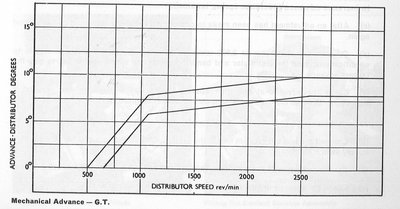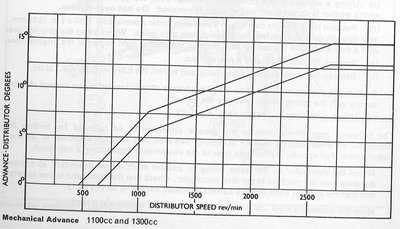123 Ignition MAP advance curve
10 posts
• Page 1 of 1
I just placed an order for a 123 Ignition and am curious if anyone has suggestions on setting the MAP advance curve? I have a '68 S4 SE that has been fully defederalized: custom UK-style intake manifold, B2AR metering needles, and an RD Enterprises mild steel header. My plan is to start with the advance curve in Miles Wilkins book for the non-Federal Stromberg engine and perhaps dial it back a couple of degrees to accommodate local gas (92 (R+M)/2 which is a touch under 97 RON), but I have no idea where to start with the MAP curve. Any advice is appreciated.
Thanks,
John
Thanks,
John
-

JohnCh - Second Gear

- Posts: 100
- Joined: 31 May 2018
The "MAP" function is purely to improve fuel economy. It has the same function as a mechanical vacuum advance. Under part throttle conditions when manifold vacuum is high it advances the ignition timing to improve fuel economy. It has no effect on maximum power because under wide open throttle conditions manifold vacuum is low. That's why Twin Cams don't have a mechanical vacuum advance - deemed unimportant in a performance engine back in the day!
1970 Ford Escort Twin Cam
1972 Ford Escort GT1600 Twin Cam
1980 Ford Escort 2.0 Ghia
Peugeot 505 GTI Wagons (5spdx1) (Autox1)
2022 Ford Fiesta ST.
1972 Ford Escort GT1600 Twin Cam
1980 Ford Escort 2.0 Ghia
Peugeot 505 GTI Wagons (5spdx1) (Autox1)
2022 Ford Fiesta ST.
- 2cams70
- Coveted Fifth Gear

- Posts: 2050
- Joined: 10 Jun 2015
Thanks, I understand the principle of vacuum advance, but not sure how to translate that into numbers. Since posting my question above, the US distributor for the 123 provided a link to a map put together by a customer. The advance curve looks very close to the Non-Federal Stromberg curve in Wilkins' book, but do the MAP values look like a good starting point? There appears to be an error at 26 kp with two different values at that pressure, but do the remaining values look directionally correct?
500rpm 9 deg
1000rpm 14.6 deg
2500rpm 25.7 deg
4500 rpm 29.5 deg
6500 rpm 33 deg
8000 rpm 33 deg
MAP
0 kp 0 deg
26 kp 0 deg
26 kp 9 deg
50 kp 9 deg
87 kp 2.3 deg
100 kp 0 deg
200 kp 0 deg
Thanks,
John
500rpm 9 deg
1000rpm 14.6 deg
2500rpm 25.7 deg
4500 rpm 29.5 deg
6500 rpm 33 deg
8000 rpm 33 deg
MAP
0 kp 0 deg
26 kp 0 deg
26 kp 9 deg
50 kp 9 deg
87 kp 2.3 deg
100 kp 0 deg
200 kp 0 deg
Thanks,
John
-

JohnCh - Second Gear

- Posts: 100
- Joined: 31 May 2018
I've attached some data below for both Ford crossflow and LTC engines for reference taken from a Ford workshop manual. If you get it right you might get an engine that is "crisper" in its throttle response form a cruise condition with slightly better fuel economy. I don't know what induction system you are using but most DCOE's don't have provision for a vacuum advance take off port however (ed. sorry I see you are using SU's - not an area of expertise for me I'm afraid!). The Lotus engines never had provision for vacuum advance. I believe that later USA emission spec. Elans had a vacuum retard provision which looks similar but totally different in operation and used only for emission reduction purposes.
Note the Lotus curve doesn't look like what's in Miles Wilkins even when you adjust for crankshaft vs distributor speed and advance. I think I'd be more inclined to believe the Ford/Lotus workshop manual!
Note the Lotus curve doesn't look like what's in Miles Wilkins even when you adjust for crankshaft vs distributor speed and advance. I think I'd be more inclined to believe the Ford/Lotus workshop manual!
- Attachments
1970 Ford Escort Twin Cam
1972 Ford Escort GT1600 Twin Cam
1980 Ford Escort 2.0 Ghia
Peugeot 505 GTI Wagons (5spdx1) (Autox1)
2022 Ford Fiesta ST.
1972 Ford Escort GT1600 Twin Cam
1980 Ford Escort 2.0 Ghia
Peugeot 505 GTI Wagons (5spdx1) (Autox1)
2022 Ford Fiesta ST.
- 2cams70
- Coveted Fifth Gear

- Posts: 2050
- Joined: 10 Jun 2015
Thanks, the vacuum advance graph is useful. Converting KPa to HG so I can compare the 123 map with the graph highlights a couple of things:
The two entries in the 123 map at 26 KPa should probably read 16 kpa = 0 deg and 26KPa = 9 deg so it approximates the starting and peak points shown on the graph.
Peak value for vacuum advance is about the same, but where the 123 map shows advance dropping back down to 0 at high vacuum (9 deg @ 15 HG > 2.3 deg @ 26 HG > 0 deg @ 30 HG) , the graph below shows it plateauing from 16 HG to 20 HG where the graph stops. I'm not sure what peak vacuum is normal in these engines, so it could be that the 123 map values are chosen to avoid too much advance around idle based on the mechanical advance map, or that peak values are closer to the 20 HG shown in the graph and the higher vacuum numbers in the map are just plug numbers.
Thanks,
John
The two entries in the 123 map at 26 KPa should probably read 16 kpa = 0 deg and 26KPa = 9 deg so it approximates the starting and peak points shown on the graph.
Peak value for vacuum advance is about the same, but where the 123 map shows advance dropping back down to 0 at high vacuum (9 deg @ 15 HG > 2.3 deg @ 26 HG > 0 deg @ 30 HG) , the graph below shows it plateauing from 16 HG to 20 HG where the graph stops. I'm not sure what peak vacuum is normal in these engines, so it could be that the 123 map values are chosen to avoid too much advance around idle based on the mechanical advance map, or that peak values are closer to the 20 HG shown in the graph and the higher vacuum numbers in the map are just plug numbers.
Thanks,
John
-

JohnCh - Second Gear

- Posts: 100
- Joined: 31 May 2018
Out of interest where/how are you getting the vacuum signal?
On Weber head cars getting a good vacuum signal is troublesome as a vacuum take offs comes from a single cylinder. So they tend to pulse strongly and need some effort to smooth them out enough to use for advanced. There been a few posts with people trying to use vac advance on weber heads and what they have done to smooth the signal without destroying it too much. I also have vague memory of the 123 Ignition have a SW function to help do that but not sure how effective it was.
Guessing this isn't such a problem for Stromberg heads with there twin inlets and balance manifolds thou.
On Weber head cars getting a good vacuum signal is troublesome as a vacuum take offs comes from a single cylinder. So they tend to pulse strongly and need some effort to smooth them out enough to use for advanced. There been a few posts with people trying to use vac advance on weber heads and what they have done to smooth the signal without destroying it too much. I also have vague memory of the 123 Ignition have a SW function to help do that but not sure how effective it was.
Guessing this isn't such a problem for Stromberg heads with there twin inlets and balance manifolds thou.
'73 +2 130/5 RHD, now on the road and very slowly rolling though a "restoration"
- mbell
- Coveted Fifth Gear

- Posts: 2704
- Joined: 07 Jun 2013
The Strombergs reportedly are much better in this regard and the 123 Ignition's software does some level of filtering to account for the pulsing. My plan is to take a T off the line feeding the headlamps and add restrictor and/or small damping reservoir if needed. Of course if none of that works, then I'll simply disable the vacuum advance feature and stick with mechanical advance as per the original design. It seems silly not to at least give this a try given the distributor provides the option.
-John
-John
-

JohnCh - Second Gear

- Posts: 100
- Joined: 31 May 2018
?. and breathe.... 


Cheers,
Pete.
http://www.petetaylor.org.uk
LOTUS ELAN flickr GROUP: https://www.flickr.com/groups/2515899@N20
flickr: http://www.flickr.com/photos/16096573@N02/sets/72157624226380576/
https://www.flickr.com/photos/16096573@N02/
Pete.
http://www.petetaylor.org.uk
LOTUS ELAN flickr GROUP: https://www.flickr.com/groups/2515899@N20
flickr: http://www.flickr.com/photos/16096573@N02/sets/72157624226380576/
https://www.flickr.com/photos/16096573@N02/
-

elansprint71 - Coveted Fifth Gear

- Posts: 4437
- Joined: 16 Sep 2003
Note that the charts show advance and RPM at the distributor. This should be X 2 for both at the engine crankshaft.
1970 Ford Escort Twin Cam
1972 Ford Escort GT1600 Twin Cam
1980 Ford Escort 2.0 Ghia
Peugeot 505 GTI Wagons (5spdx1) (Autox1)
2022 Ford Fiesta ST.
1972 Ford Escort GT1600 Twin Cam
1980 Ford Escort 2.0 Ghia
Peugeot 505 GTI Wagons (5spdx1) (Autox1)
2022 Ford Fiesta ST.
- 2cams70
- Coveted Fifth Gear

- Posts: 2050
- Joined: 10 Jun 2015
10 posts
• Page 1 of 1
Total Online:
Users browsing this forum: No registered users and 21 guests




